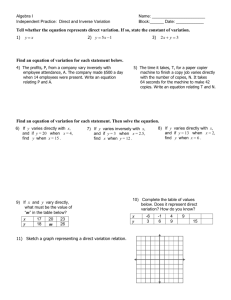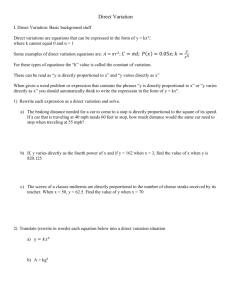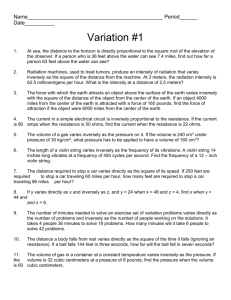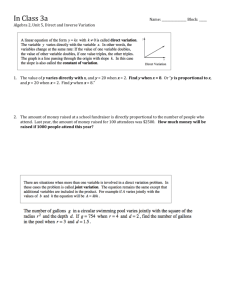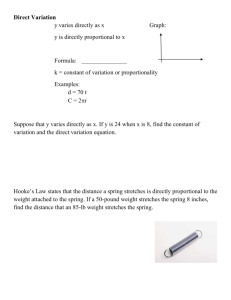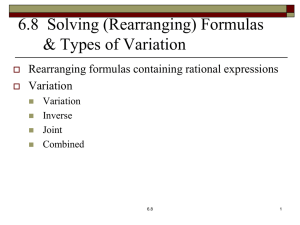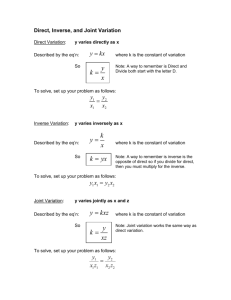Variation
advertisement
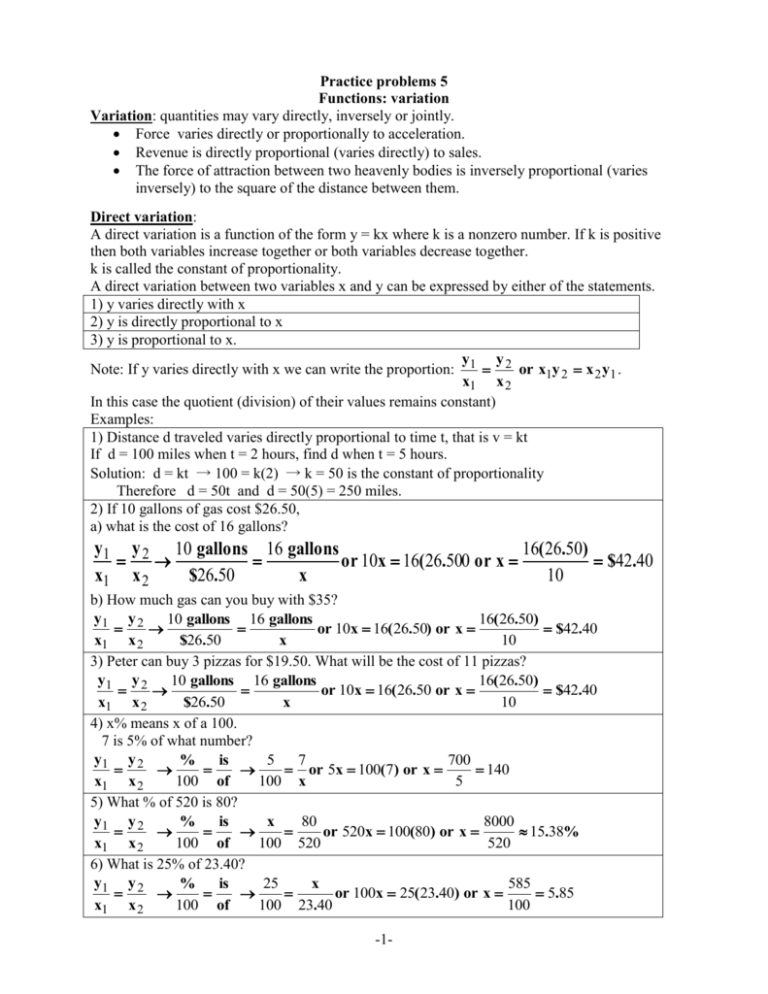
Practice problems 5 Functions: variation Variation: quantities may vary directly, inversely or jointly. Force varies directly or proportionally to acceleration. Revenue is directly proportional (varies directly) to sales. The force of attraction between two heavenly bodies is inversely proportional (varies inversely) to the square of the distance between them. Direct variation: A direct variation is a function of the form y = kx where k is a nonzero number. If k is positive then both variables increase together or both variables decrease together. k is called the constant of proportionality. A direct variation between two variables x and y can be expressed by either of the statements. 1) y varies directly with x 2) y is directly proportional to x 3) y is proportional to x. y y Note: If y varies directly with x we can write the proportion: 1 2 or x1y 2 x 2 y1 . x1 x 2 In this case the quotient (division) of their values remains constant) Examples: 1) Distance d traveled varies directly proportional to time t, that is v = kt If d = 100 miles when t = 2 hours, find d when t = 5 hours. Solution: d = kt → 100 = k(2) → k = 50 is the constant of proportionality Therefore d = 50t and d = 50(5) = 250 miles. 2) If 10 gallons of gas cost $26.50, a) what is the cost of 16 gallons? y1 y 2 10 gallons 16 gallons 16( 26.50) or 10x 16( 26.500 or x $42.40 x1 x 2 $26.50 x 10 b) How much gas can you buy with $35? y1 y 2 10 gallons 16 gallons 16(26.50) or 10x 16(26.50) or x $42.40 x1 x 2 $26.50 x 10 3) Peter can buy 3 pizzas for $19.50. What will be the cost of 11 pizzas? y1 y 2 10 gallons 16 gallons 16(26.50) or 10x 16( 26.50 or x $42.40 x1 x 2 $26.50 x 10 4) x% means x of a 100. 7 is 5% of what number? y1 y 2 % is 5 7 700 or 5x 100(7) or x 140 x1 x 2 100 of 100 x 5 5) What % of 520 is 80? y1 y 2 % is x 80 8000 or 520x 100(80) or x 15.38% x1 x 2 100 of 100 520 520 6) What is 25% of 23.40? y1 y 2 % is 25 x 585 or 100x 25( 23.40) or x 5.85 x1 x 2 100 of 100 23.40 100 -1- 7) A dress is sold for $55 at a 20% discount sale. What was the original price of the dress? Solution: the original price is 100%. Because of the 20% discount it is sold at an 80% value. Therefore, 80% of the original cost is $55. y1 y 2 % is 80 55 5500 or 80x 100(55) or x $68.75 x1 x 2 100 of 100 x 80 Inverse variation function: k where k is a nonzero number. x k is called the constant of proportionality. If k is positive, as one variable increases the other decreases. An inverse variation between two variables x and y can be expressed by either of the statements. 1) y varies inversely with x 2) y is inversely proportional to x Note: If y varies inversely with x we can write the proportion: or x1y1 x 2 y 2 In an inverse variation, the product of their values remains constant. Examples: 1. The force of attraction between two heavenly bodies is inversely proportional to the square of the distance between them. If F = 12 when d = 4, find F when d = 2 k k Solution: F 12 k 192 . The constant of proportionality is k = 192. d2 42 k 192 192 192 Answer: When d = 2, F=48 F F F 48 4 d2 d2 22 An inverse variation is a function of the form y 2 2 P kd 2 n 18 k ( 4) 2 9 d 12 and n 4 P k F 12 4 2 18 3 27 3.375d 2 3.375 P 16 8 n 3.375d 2 n 12 4 F 2 2 48 22 2. If 8 men can finish a construction job in 20 days, at that rate how long will it take 12 men? Solution: more men working, less time to finish the job indicates an inversely proportional relation. Therefore: (men)(days) = K (8 men)(20days) = (12 men)(x days) 160 1 x days 13 days 12 3 3. P varies directly with the square of d and inversely with the square root of n. P = 18 when d = 4 and n = 9. Find P when d = 12 and n = 4. Or: x1y1 x 2 y 2 F1d1 F2 d 2 2 3.375(12 2 ) 4 243 Joint Variation: Z = k(xy) When a quantity Z is proportional to the product of two variables x and y then we say that Z varies jointly with the product of x and y. -2- Examples: 1. The area of a triangle varies jointly with the length of the base b and the height h. The constant of proportionality is ½. Find the area of a triangle with base b = 20 feet and height h=15 feet. 1 1 A bh A (20)(15) 150 squared feet. 2 2 2. Kinetic Energy E varies jointly with the product of the mass m and the square of the velocity v. If E = 45 when m= 10 and v=3. a) Find the constant of proportionality. Solution: 45 1 E kmv 2 45 k (10)(3) 2 k 90 2 1 Therefore , E mv 2 2 b) Find E when m = 30 and v = 80 1 1 E mv 2 E (30)(80) 2 E 96000 2 2 3. A farmer obtains 30 eggs from 5 chickens a week (7 days). At that rate how many chickens are needed to obtain 100 eggs in 2 weeks (14 days) 5 chickens 30 eggs 7 days x chickens 100 eggs 14 days For a fixed number of day, more chickens will produce more eggs. Therefore the number if eggs e us directly proportional to the number of chickens. To obtain a fixed number of eggs, more chickens will produce the necessary eggs in less number of days. Therefore there is an inverse variation between the number of chickens and the number of days necessary to produce a fix number of eggs. Cd C d ke Cd (5)( 7) (x)(14) (5)(7)(100) 1 k 1 1 2 2 x 8 chickens d e e1 e2 30 100 30(14) 3 The farmer need 9 chickens to guarantee 100 eggs every two weeks. Another Method: The column where the question (x) is located is called the reference column. The (+) used in the following explanation is just a symbol, it has no sign value. Step 1. Place a (+ ) sign in the reference column opposite where the x is located. Reference Column 5 chickens 30 eggs 7 days (+) (-) (+) x chickens 100 eggs 14 days (+) (-) Step 2. In a direct variation the (+) symbols will fall diagonally. The number of chickens is directly proportional to the number of eggs collected. Place a (+ ) in the second column diagonally to the (+) in the first column and a (-) in the other entry of the second column. Step 3. In an inverse variation the (-) symbols will fall diagonally with the (+) in the reference column.The number of chickens is inversely proportional to the number of days necessary (for a fix number of eggs). Place a (- ) in the third column in diagonally to the (+) in the reference column and a (+) in the other entry of the third column. C -3- Step 4. x product of the entries labeled ( ) (5)(100)( 7) 3500 1 8 or 9 chickens. product of the entries labeled ( ) (30)(14) 420 3 4. If 8 men can finish a construction job in 20 days working 8 hours a day, at that rate how long will it take 12 men to finish the job working 10 hours a day? Reference Column Men Days Hours per day 8 men 20 days 8 hour per day (+) (+) (+) 12 men x days 10 hours per day (-) (-) Step 1. Place a (+) in the entry above the entry where the x is located. Step 2. More men will need less number of days to finish the job (inversely). In the first column place a (-) diagonally to the (+) in the reference column and a (-) in the opposite row of the first column. Step 3. More hours per day will need less number of days (for a fixed number of men working.) Therefore the number of days is inversely related to the number of hours per day. Place a (-) in the third column diagonally to the (+) in the reference row, and a (+) in the opposite of the third column. Step 4. x product of the entries labeled ( ) (8)( 20)(8) 1280 2 10 days product of the entries labeled ( ) (12)(10) 120 3 5. Pancho wants to travel. He can travel 1000 miles in a rented car that makes 25 miles per gallon at $2.75 a gallon. For the same expense, how far can he travel in his own car that makes 18 miles per gallon at $2.55 a gallon. Reference column Distance Efficiency Cost 1000 miles 25 miles per gallon $2.75 per gallon (+) (-) (+) x miles 18 miles per gallon $2.55 per gallon (+) (-) product of the entries labeled ( ) (1000)(18)( 2.75) 1280 776.47 miles Step 4. x product of the entries labeled ( ) ( 25)( 2.55) 120 D1C1 D 2 C 2 kE DC 1000( 2.75) 2.55x D C k E E E 25 18 1 2 Another method: x 1000( 2.75)(18) 776.47 miles 25( 2.55) -4- 6. The force of attraction between two heavenly bodies is inversely proportional to the square of the distance between them. If F = 12 when d = 4, find F when d = 2 Force (+) 12 x Square of distance (+) 16 4 (-) 12(16) 48 4 7. The electrical resistance of a wire varies directly with the length of the wire and inversely with the square of the diameter of the wire. If a wire 432 Feet long a 4 millimeters in diameter has a resistance of 1.24 ohms, find the length of a wire of the same material resistance is 1.44 ohms and whose diameter is 3 millimeters. Resistance and length are directly proportional, place (+) signs in the entries where 432 and 1. 44 are located Resistance and square of diameter are inversely related. Resistance Length Square of Diameter 1.24 ohms 432 feet 16 squared millimeters (-) (+) (-) 1.44 ohm x 9 squared millimeters (+) (+) x Length x product of the entries labeled ( ) (1.44)( 432)(9) 282.19 feet product of the entries labeled ( ) (1.24)(16) -5-
